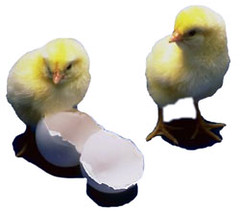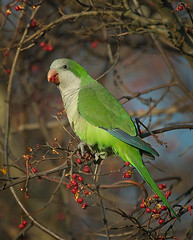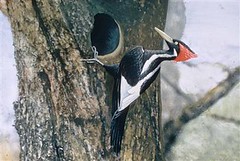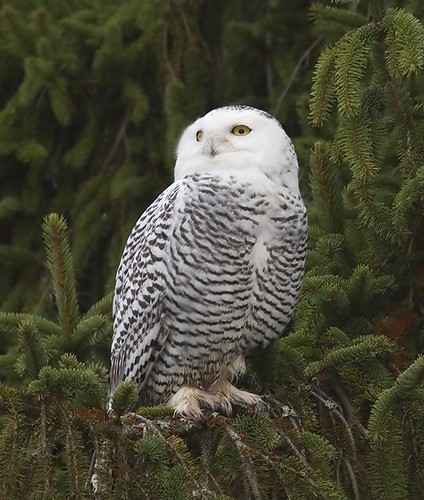People Hurting Birds

Deceived by all the bird flu sensationalism, an Egyptian farmer abandoned 10,000 newly hatched chicks to their fate on a desert road east of Cairo fearing they might be infected with the deadly bird flu virus, a police official said on Wednesday. Shocked motorists travelling on the road about 130 km (80 miles) east of Cairo contacted police after seeing the chicks running loose on the tarmac on Tuesday, the official added. Health officials gathered the chicks and confirmed after testing that they were not carrying the virus.
Birds .. proving once again that People Really Are Monkeys

There's nothing that stirs man's blood like the thrill of the hunt. The fact that the object of this hunt, a feral monk parrot, Myiopsitta monachus (pictured), was destined to become a pet to this particular man's girlfriend only added to this thrill. I don't want to spoil this story for you by elaborating further, except to say that it is an Honorable Mention on the Darwin Awards website. GrrlScientist observes: it's amazing what a little testosterone can do to a person.
Ivory-billed Woodpecker News
 As scientists debate whether the ivory-billed woodpecker, Campephilus principalis (pictured), still exists in the Big Woods of Arkansas, environmentalists have enlisted the bird as a key soldier in their fight against a massive irrigation project. The irrigation project has been on the table since the mid-1980s, when studies showed that groundwater aquifers in the area, which lies in east-central Arkansas, were being depleted by rice growers. To solve that, the U.S. Army Corps of Engineers' Grand Prairie Area Demonstration Project is working with farmers to build reservoirs on their land and elsewhere that will be filled via a canal and pipeline network with water pumped from the White River. But Lisa Swann of the National Wildlife Federation and other groups have long fought the Grand Prairie project as a federal boondoggle that poses serious environmental threats and squanders tax dollars to deliver huge subsidies to farmers. This "mammoth sucking machine" would hurt wetlands, degrade water quality and threaten species in the region from ducks to mussels, the National Wildlife Federation says in one publication about Grand Prairie.
As scientists debate whether the ivory-billed woodpecker, Campephilus principalis (pictured), still exists in the Big Woods of Arkansas, environmentalists have enlisted the bird as a key soldier in their fight against a massive irrigation project. The irrigation project has been on the table since the mid-1980s, when studies showed that groundwater aquifers in the area, which lies in east-central Arkansas, were being depleted by rice growers. To solve that, the U.S. Army Corps of Engineers' Grand Prairie Area Demonstration Project is working with farmers to build reservoirs on their land and elsewhere that will be filled via a canal and pipeline network with water pumped from the White River. But Lisa Swann of the National Wildlife Federation and other groups have long fought the Grand Prairie project as a federal boondoggle that poses serious environmental threats and squanders tax dollars to deliver huge subsidies to farmers. This "mammoth sucking machine" would hurt wetlands, degrade water quality and threaten species in the region from ducks to mussels, the National Wildlife Federation says in one publication about Grand Prairie.
Avian Influenza News
 Scientists who have made a big leap in unraveling the genetic code of bird flu viruses (pictured) found a new clue that may help explain why the notorious H5N1 strain is so deadly. St. Jude Children's Research Hospital in Memphis, Tennessee (USA), is home to a remarkable viral library, housing samples of about 11,000 influenza viruses that Dr. Robert Webster has gathered from around the world since 1976. These flu viruses have infected people, pigs and other animals, and includes approximately 7,000 bird flu viruses gathered from poultry, ducks, gulls and other species. Yesterday, St. Jude researchers reported in the top-tier journal Science that they have completed the first large genetic analysis of more than 300 of these bird flu viruses. They identified 2,196 bird flu genes and 160 complete viral genomes, doubling the amount of genetic information available to scientists studying how these viruses evolve and spread over time. Decoding all the influenza genes instead of select ones will help scientists learn how these constantly evolving viruses change and spread, and why some are so much more virulent than others.
Scientists who have made a big leap in unraveling the genetic code of bird flu viruses (pictured) found a new clue that may help explain why the notorious H5N1 strain is so deadly. St. Jude Children's Research Hospital in Memphis, Tennessee (USA), is home to a remarkable viral library, housing samples of about 11,000 influenza viruses that Dr. Robert Webster has gathered from around the world since 1976. These flu viruses have infected people, pigs and other animals, and includes approximately 7,000 bird flu viruses gathered from poultry, ducks, gulls and other species. Yesterday, St. Jude researchers reported in the top-tier journal Science that they have completed the first large genetic analysis of more than 300 of these bird flu viruses. They identified 2,196 bird flu genes and 160 complete viral genomes, doubling the amount of genetic information available to scientists studying how these viruses evolve and spread over time. Decoding all the influenza genes instead of select ones will help scientists learn how these constantly evolving viruses change and spread, and why some are so much more virulent than others.
Turkey accused its neighbours on Friday of hushing up outbreaks of bird flu, complicating the fight against a virus that has killed four Turkish children. "It is unofficially known that this illness exists in our neighbouring countries which are ruled by closed regimes, but these countries do not declare this because of their systems," Agriculture Minister Mehdi Eker told a news conference. He did not name the countries he had in mind, but Iran and Syria are two likely targets of the criticism. Turkey has culled more than 1.1 million wild birds and poultry since the outbreak began two weeks ago. The outbreak has hit the $3 billion poultry industry hard. The Turkish government unveiled a $40 million aid package on Friday for poultry firms hit by bird flu, including compensation for culled chickens and postponement of tax and debt payments. However, poultry industry representatives said the measures did not go far enough. GrrlScientist complains; this story does not describe what poultry industry officials wanted that was not granted by the government, so this makes it impossible for me to rant about the situation here.
Do the wild birds that fly through cold winter skies to warmer lands silently carry deadly bird flu around the world? Or are they simply potential victims? "Scientists are increasingly convinced that at least some migratory waterfowl are now carrying the H5N1 virus in its highly pathogenic form, sometimes over long distances, and introducing the virus to poultry flocks in areas that lie along their migratory routes," the World Health Organisation said in its latest bird flu fact sheet last week. It said scientists found that viruses from the most recently affected countries, all of which lie along migratory routes, were almost identical to viruses recovered from dead migratory birds at Qinghai Lake in China. The viruses from Turkey's first human cases were also virtually identical to the Qinghai Lake strain, it added. "I think that wild birds may introduce the virus but it is through man and man's marketing systems (the poultry trade) that the disease spreads. It is also possible that poultry can transmit the virus to wildlife when they share the same ecosystem," said Juan Lubroth, the senior officer for infectious diseases with the United Nations Food and Agriculture Organisation (FAO). "The pattern of outbreaks between Asia and eastern Europe do not follow any known pathway for migrant birds, which tend to fly on northerly-southerly routes. They don't go east-west, Dr Richard Thomas of BirdLife International points out. Wild birds that were discovered to have the H5 virus, such as swans found in Croatia in October 2005, were already dead -- suggesting they were victims rather than vectors.
Streaming Birds
 This week on BirdNote you can learn more about Western Scrub-Jays, Aphelocoma californica, on the Move; The Comeback of the Peregrine Falcon, Falco peregrinus (featuring Ruth Taylor's photograph of Bell, the resident female peregrine falcon, nesting on the Washington Mutual Bank (WAMU) tower in downtown Seattle); Nesting Great Horned Owls, Bubo virginianus (first of a series about the nesting season); How the Robin Got its Name; and on Friday (today), you can learn more about the upcoming Skagit Bald Eagle Festival (February 4-5). BirdNote programs are two-minute vignettes that incorporate the rich sounds of birds provided by Cornell University and by other sound recordists, with photographs and written stories that illustrate the interesting -- and in some cases, truly amazing -- abilities of birds. Some of the shows are Pacific Northwest-oriented, but many are of general interest. BirdNote can be heard live, Monday through Friday, 8:58-9:00AM in Western Washington state and Southern British Columbia on KPLU radio and now also in North Central Washington state on KOHO radio. All episodes are available in the BirdNote archives, both in written transcript and mp3 formats, along with photographs. Listener ideas and comments are welcomed. [rss mp3/podcast].
This week on BirdNote you can learn more about Western Scrub-Jays, Aphelocoma californica, on the Move; The Comeback of the Peregrine Falcon, Falco peregrinus (featuring Ruth Taylor's photograph of Bell, the resident female peregrine falcon, nesting on the Washington Mutual Bank (WAMU) tower in downtown Seattle); Nesting Great Horned Owls, Bubo virginianus (first of a series about the nesting season); How the Robin Got its Name; and on Friday (today), you can learn more about the upcoming Skagit Bald Eagle Festival (February 4-5). BirdNote programs are two-minute vignettes that incorporate the rich sounds of birds provided by Cornell University and by other sound recordists, with photographs and written stories that illustrate the interesting -- and in some cases, truly amazing -- abilities of birds. Some of the shows are Pacific Northwest-oriented, but many are of general interest. BirdNote can be heard live, Monday through Friday, 8:58-9:00AM in Western Washington state and Southern British Columbia on KPLU radio and now also in North Central Washington state on KOHO radio. All episodes are available in the BirdNote archives, both in written transcript and mp3 formats, along with photographs. Listener ideas and comments are welcomed. [rss mp3/podcast].
You might be interested to follow the birding adventures of David and his wife, Gayle, as presented on their audio magazine of birds and birding, On The Wing. They index a variety of their birding adventures in the UK and other places, including some of my old stomping grounds in the Pacific Northwest. [mp3/podcast].
Miscellaneous Birds
 The parents of Toga -- the penguin chick whose disappearance last month was followed around the world -- have a new egg (pictured), British zookeepers said this week, prompting dozens of well-wishers to send congratulatory e-mails. Toga, a 3-month-old jackass penguin, Sphenicus demersis, disappeared in December from Amazon World, on the Isle of Wight in southern England. Despite scores of reported sightings and an on-air confession from a man who called a television station to admit to stealing the bird, Toga has not been found and is presumed dead. Zoo officials have installed closed circuit television cameras and motion sensors to make sure that Toga's expected sibling remains safely with his parents, who are a rare species of penguin found on the southern coast of Africa.
The parents of Toga -- the penguin chick whose disappearance last month was followed around the world -- have a new egg (pictured), British zookeepers said this week, prompting dozens of well-wishers to send congratulatory e-mails. Toga, a 3-month-old jackass penguin, Sphenicus demersis, disappeared in December from Amazon World, on the Isle of Wight in southern England. Despite scores of reported sightings and an on-air confession from a man who called a television station to admit to stealing the bird, Toga has not been found and is presumed dead. Zoo officials have installed closed circuit television cameras and motion sensors to make sure that Toga's expected sibling remains safely with his parents, who are a rare species of penguin found on the southern coast of Africa.
 While the cost of chasing birds to the far corners of the earth is high, virtually everyone afflicted with this obsession claims the rewards -- beauty, mystery, awe and longer lists -- are well worth it. ''A tiny warbler that weighs maybe 3 ounces and is not more than 3 inches long can fly from the edge of the taiga in Canada to Costa Rica and Puerto Rico. The more you see them, the more amazing they are to you. You can't ever get enough,'' says Financial reporter Christine Williamson, who lives in Chicago when she is not chasing birds across the globe. American birders spend over $32 billion annually on their hobby and about 18 million travel to see birds, according to a 2001 study by the U.S. Fish and Wildlife Service. The average birder that year was 49 with an above-average income and education level. ''In addition to seeing these incredibly beautiful and diverse birds, ranging from flightless penguins to little tiny hummingbirds, it takes you to places that are just stunning and show a diversity of life and the diversity of this planet,'' said Tom Snetsinger. Tom is the son of legendary birder, Phoebe Snetsinger who saw more birds -- 8,450 of the world's approximately 10,000 species -- than any other person who ever lived. Phoebe Snetsinger was already an avid birder when she was given less than a year to live after a diagnosis of malignant melanoma, so she hurled herself into birding trips more than ever. She ended up living another two decades before dying in a bus crash in Madagascar. ''Birding is a lens to look at the world. It guides me to places I'd otherwise never go,'' said Tom. GrrlScientist note: I absolutely agree with Tom. I have experienced more habitat types, learned more about ecology and geology, met more people, seen more animals and had more incredible experiences as a direct result of birding than most people I know -- except other birders with more money!
While the cost of chasing birds to the far corners of the earth is high, virtually everyone afflicted with this obsession claims the rewards -- beauty, mystery, awe and longer lists -- are well worth it. ''A tiny warbler that weighs maybe 3 ounces and is not more than 3 inches long can fly from the edge of the taiga in Canada to Costa Rica and Puerto Rico. The more you see them, the more amazing they are to you. You can't ever get enough,'' says Financial reporter Christine Williamson, who lives in Chicago when she is not chasing birds across the globe. American birders spend over $32 billion annually on their hobby and about 18 million travel to see birds, according to a 2001 study by the U.S. Fish and Wildlife Service. The average birder that year was 49 with an above-average income and education level. ''In addition to seeing these incredibly beautiful and diverse birds, ranging from flightless penguins to little tiny hummingbirds, it takes you to places that are just stunning and show a diversity of life and the diversity of this planet,'' said Tom Snetsinger. Tom is the son of legendary birder, Phoebe Snetsinger who saw more birds -- 8,450 of the world's approximately 10,000 species -- than any other person who ever lived. Phoebe Snetsinger was already an avid birder when she was given less than a year to live after a diagnosis of malignant melanoma, so she hurled herself into birding trips more than ever. She ended up living another two decades before dying in a bus crash in Madagascar. ''Birding is a lens to look at the world. It guides me to places I'd otherwise never go,'' said Tom. GrrlScientist note: I absolutely agree with Tom. I have experienced more habitat types, learned more about ecology and geology, met more people, seen more animals and had more incredible experiences as a direct result of birding than most people I know -- except other birders with more money!

There is an epidemic of bird ticks this winter in the Carolina Piedmont, and it's right on schedule. For some super-close-up photos and intriguing information about these gloriously repulsive ectoparasites, please scroll down on the link provided to This Week at Hilton Pond. As always, they include a list of birds banded during the period, including several mugshots of a partial albino American Goldfinch, Carduelis tristis (pictured). Fortunately, they also include suggestions for dealing with a tick-infested bird.
The Fine Print: Thanks to my bird pals; Dawn, Joel, Bill, Larry, Ellen and Ron for some of the news story links that you are enjoying here.
I also appreciate long-time readers, Jamie, Tony and anonymous blog reader, for nominating Birds in the News for a 2005 Koufax Award for Best Series! Voting will probably begin at the end of January. There will be an announcement here, along with more details, when voting begins.
Be sure to check out the other animals in today's Friday Ark #71.
Previous : : Birds in the News : : Next
tags: Birds in the News, Birds News, ornithology, birds, avian, newsletter

Academic Job Applications: none sent this week, but I am preparing to send out several postdoc applications soon.
Survival Job Applications: none this week. The academic semester has begun, so I can plan on becoming quite lean over the next five months unless someone decides to hire me.
Survival Job Rejections: 1


Yeah! You got it back together! Nice Job!
Great Birds in the News edition! I always look forward to each edition.
I like the cute moving bird you added above the Global Stupidity Advisory System. What type is it?
Wow that was a long and information filled post. I see why you wanted to smite Blogger.
FYI: As far as survival jobs go I would recommend trying Starbucks (healthcare for part time workers, yay) or Whole Foods. Or anybody on this list:
http://money.cnn.com/magazines/fortune/bestcompanies/
Dawn; I managed to recover part of the document, but I lost two sections, "Birds in Science" (my favorite) and a new section this week, "Bird Festivals" (this was going to be an experiment to inform people about birds watching "festivals" throughout the world)
Torris; if you rest your mouse on the bird, its species and scientific name will magically appear on your screen.
Bill; i have interviewed with several of those places listed, especially starbux, which i've interviewed with several times. who refuses to hire me.
sigh. long-winded rant .. deleted (it's just too depressing to even talk about. really. believe me on this).
seriously; my biggest daily struggle is not becoming overwhelmed with depression.
I'm glad you got this back together again. That must have been an ordeal.
Don't you have a Paypal link so you can panhandle your appreciative audience during lean periods? I looked for one at your blogsite but could not find it. We don't want you to turn into Grrl Starvationist.
John; i edited and then published what i had left. i was too disgusted to search for all the (excuse my weak attempt at humor) missing links.
biosparite i do indeed have a paypal link. because ScienceBlogs has a fairly rigid format (at least at the moment), my paypal button is located almost at the bottom of the left sideboard, just above the chickadee and the Global Stupidity Warning System icon. i tremendously appreciate anything that people donate to my self-preservation.
"i was already feeling rather cranky and underappreciated"
Don't, we do appreciate what you are doing. I'm glad you managed to recover most of your work.
Oh, yeah, found it (duh). I guess the ADHD had kicked in when I first went looking.
Caio de Gaia; oooohh, another fan? you made my day!
biosparite; heh. well, the button is easy to overlook, which is not necessarily a Bad Thing since i don't want people to think the only reason i write this blog is for the reward$.
Is the blinking owl from your old site going to fly over to this site?
Torris; yes, indeed, there will be a corporate meeting specifically to discuss Blinking Owl Irruption.
On a serious note:
http://www.sciencedaily.com/upi/index.php?feed=Science&article=UPI-1-20…
http://www.guardian.co.uk/conservation/story/0,,1695897,00.html
and also disturbing
http://www.rspb.org.uk/scotland/action/lewis/news/maps.asp
I've been trying to call people's attention to the windfarm problem here in Portugal (they are going to fill the entire landscape with these things) but no one cares: it's "green", it's for the good of the environment, etc. When I talk to my friends about this they think I'm crazy. The problem is that we have the greedy people building the things playing with the environmental concerns of the population. Do you know of any good scientific studies on the impact of these things in bird populations?
"A tiny warbler that weighs maybe 3 ounces "... wow - that has got to be the biggest warbler on record.
But seriously - what a wonderful resource you have here, GS!